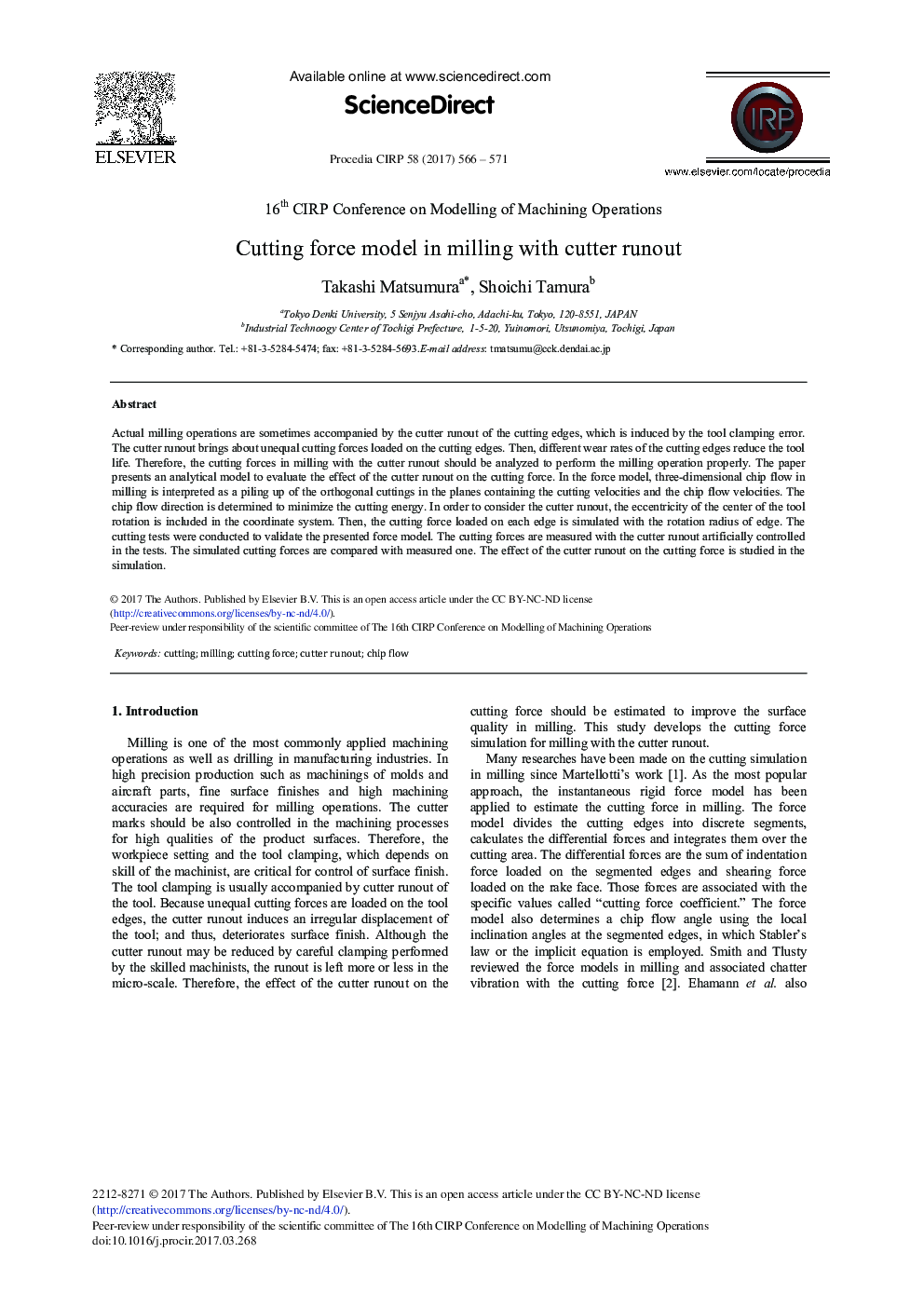| کد مقاله | کد نشریه | سال انتشار | مقاله انگلیسی | نسخه تمام متن |
|---|---|---|---|---|
| 5470313 | 1519294 | 2017 | 6 صفحه PDF | دانلود رایگان |
عنوان انگلیسی مقاله ISI
Cutting Force Model in Milling with Cutter Runout
ترجمه فارسی عنوان
مدل نیروی برش در فرزکاری با برش
دانلود مقاله + سفارش ترجمه
دانلود مقاله ISI انگلیسی
رایگان برای ایرانیان
کلمات کلیدی
برش دادن، فرز نیروی برشی، راننده برش جریان تراشه،
ترجمه چکیده
عملیات فرزکاری واقعی گاهی اوقات با برش لبه های برش همراه است که با خطای بستن ابزار بوجود می آید. چرخش برش باعث نیروهای برش نابرابر لبه برش می شود. سپس، نرخ سایش مختلف لبه های برش، عمر ابزار را کاهش می دهد. بنابراین، نیروهای برش در آسیاب با برش برش باید برای انجام عملیات فرزکاری به درستی مورد تجزیه و تحلیل قرار گیرد. این مقاله یک مدل تحلیلی برای ارزیابی اثر برش برش بر نیروی برش ارائه می دهد. در مدل نیروی، جریان تراشه سه بعدی در میلز به عنوان یک شمع سازی از قلمه های متعامد در هواپیما حاوی سرعت برش و سرعت جریان تراشه تفسیر می شود. جهت جریان تراشه برای کاهش انرژی برش تعیین می شود. به منظور در نظر گرفتن چرخش برش، بیرونی مرکزی چرخش ابزار در سیستم مختصات گنجانده شده است. سپس نیروی برش روی هر لبه با شعاع چرخشی لبه شبیه سازی می شود. تست های برش جهت اعتبارسنجی مدل ارائه شده نیرو گرفته شده است. نیروهای برش با راننده برش بطور مصنوعی تحت آزمایش قرار می گیرند. نیروهای برش شبیه سازی شده با اندازه گیری شده مقایسه شده اند. اثر ریزش برش بر نیروی برش در شبیه سازی مورد بررسی قرار می گیرد.
موضوعات مرتبط
مهندسی و علوم پایه
سایر رشته های مهندسی
مهندسی صنعتی و تولید
چکیده انگلیسی
Actual milling operations are sometimes accompanied by the cutter runout of the cutting edges, which is induced by the tool clamping error. The cutter runout brings about unequal cutting forces loaded on the cutting edges. Then, different wear rates of the cutting edges reduce the tool life. Therefore, the cutting forces in milling with the cutter runout should be analyzed to perform the milling operation properly. The paper presents an analytical model to evaluate the effect of the cutter runout on the cutting force. In the force model, three-dimensional chip flow in milling is interpreted as a piling up of the orthogonal cuttings in the planes containing the cutting velocities and the chip flow velocities. The chip flow direction is determined to minimize the cutting energy. In order to consider the cutter runout, the eccentricity of the center of the tool rotation is included in the coordinate system. Then, the cutting force loaded on each edge is simulated with the rotation radius of edge. The cutting tests were conducted to validate the presented force model. The cutting forces are measured with the cutter runout artificially controlled in the tests. The simulated cutting forces are compared with measured one. The effect of the cutter runout on the cutting force is studied in the simulation.
ناشر
Database: Elsevier - ScienceDirect (ساینس دایرکت)
Journal: Procedia CIRP - Volume 58, 2017, Pages 566-571
Journal: Procedia CIRP - Volume 58, 2017, Pages 566-571
نویسندگان
Takashi Matsumura, Shoichi Tamura,
